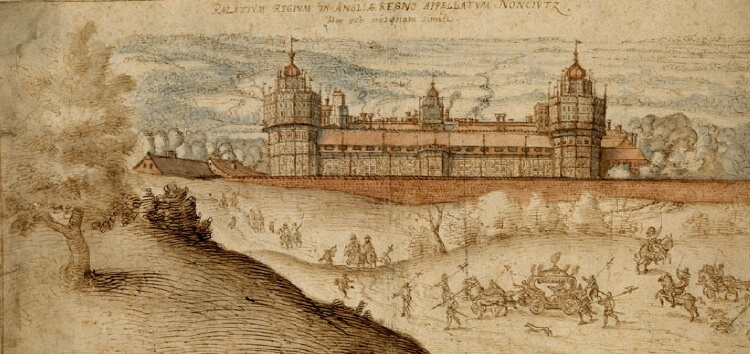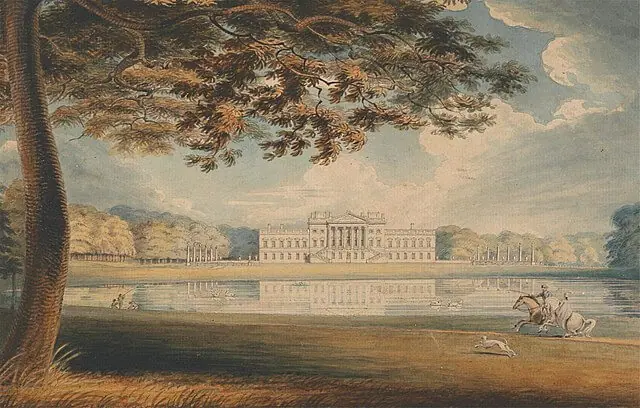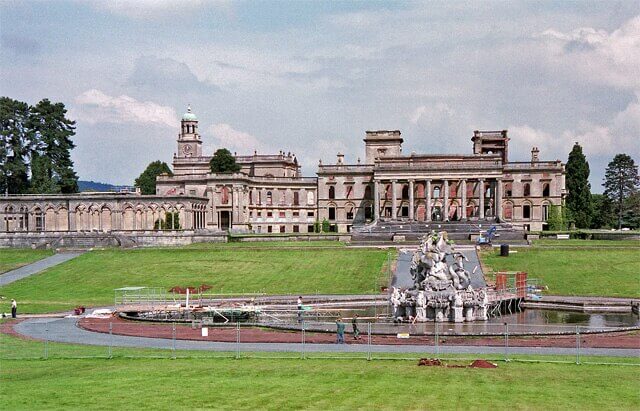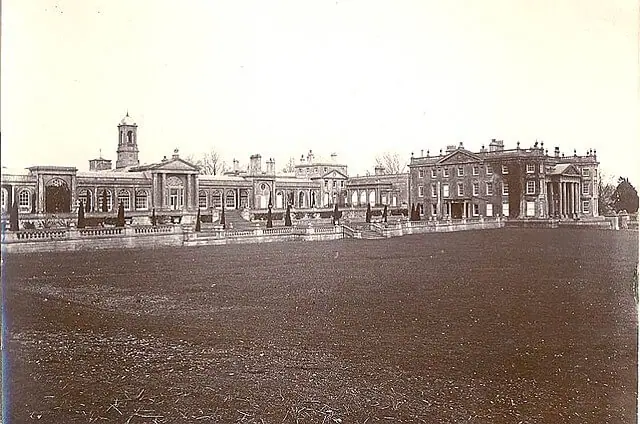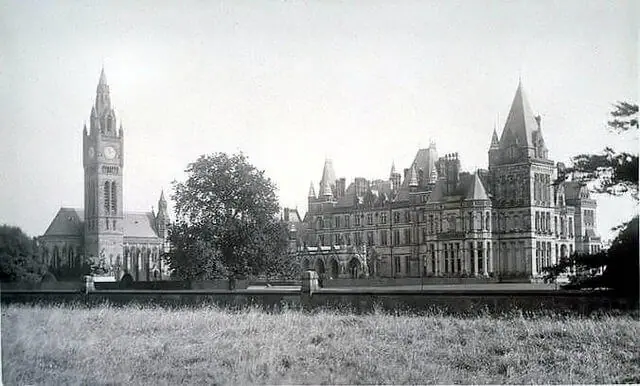Country houses are an ever-present English phenomenon – they are at once ancient markers on the landscape and a constant feature of centuries of British literary and artistic tradition. There is, however, a more lamentable side to their story. Over the centuries, thousands of country houses have been destroyed and their contents scattered. Never was this rifer than in the 20th century with over 1,200 country houses destroyed in England since 1900. This article will illustrate some of these great houses and the different ways in which they were lost.
1. Nonsuch Palace
The only royal palace on this list, Nonsuch derives its name from the claim that no such building existed to rival this house’s magnificence. This enormous palace was built by Henry VIII in 1538 and, unlike most royal residences of the time, it was built from scratch (rather than being a renovation of a castle or earlier structure). Due to its being built in a single campaign, Nonsuch boasted the newest Renaissance designs to reach England from the continent. This was all intended to display the Tudor dynasty’s opulence and power in a similar way to that expressed by Francis I of France. The Palace stood near hunting grounds near Epsom in Surrey, and although this spot is now just about in London, it would have been several miles outside the city when Nonsuch was built. After Henry VIII died in 1541, the house changed hands many times; occupants ranged from Anne of Denmark (James I’s consort), The Earls of Southampton and Montgomery to a host of Parliamentary politicians and generals during the Civil Wars.
Funnily enough for a royal palace, it was the Restoration that marked Nonsuch’s end. Eventually given to Barbara Villiers (one of Charles II’s most famous mistresses), it was pulled down and sold piecemeal to pay for her enormous gambling debts. Because of its early construction and relatively short existence, not much is known about Nonsuch. Only a handful of contemporary depictions exist and barely a trace remains on its original site.
2. Wanstead House
The second entry on this list is not so dissimilar to the first. Both houses were the absolute pinnacle of British architectural design of their day, both were ruined by debt and both were completely destroyed, leaving only their respective parks at the fringes of modern-day London. Wanstead House is a great loss. Rivalled perhaps only by Holkham Hall in Norfolk, it was one of the preeminent examples of the Neo-Palladian style that burgeoned in the early 18th century. This architectural style, which took its cues from Inigo Jones (and, of course, Palladio), became the expression of choice for a newly enriched and politically elite Whig ascendancy. Attempting to break with the tumult of the 17th century and Tory Jacobitism (and deeply suspicious of the perceived popery of Baroque architecture), this new oligarchy chose to demonstrate confidence in the Hanoverian monarchy and Protestant enlightenment with a bold, modern adaptation of Palladian classicism. As such, Wanstead became a prototype for the 18th century, ensuring the Baroque style of Blenheim Palace and castle Howard was outdated before it was ever allowed to fully catch on.
Wanstead’s history is short: it was built in 1722 from designs by the great British Neo-Palladian architect Colen Campbell, and, after just less than a century, the house and estate passed to Catherine Tyley-Lond (a great niece of Wanstead’s builder, Sir Richard Child). Despite being richest heiress in England at the time, she was seduced into marrying the wastrel William Wellesley-Pole (nephew of the Duke of Wellington) in 1812. Wellesley-Pole swiftly set about ruinously spending his wife’s fortune and fatally secured a debt of £250,000 against the estate. When no one could be found to rent the house, Wanstead was demolished in 1825 for its building materials, the sale of which generated a mere £10,000 – a paltry sum when compared to the house’s reported £360,000 construction cost some 103 years earlier.
3. Witley Court
If debt was one of the deadliest enemies of the country house, then fire must surely be another. The next entry on this list is the magnificent ruin of Witley Court in Worcestershire. Somewhat of an architectural mongrel, Witley Court was built and extended over four centuries. A brick Jacobean house was the first to stand on the site. To this, two baroque towers and wings were added in the late 17th century. The 18th century brought Great Witley parish church, which is connected to the house and has (rather anachronistically) one of the greatest Baroque church interiors outside London. Monumental classicism was introduced in the early 19th century by John Nash but these works came with a cost – the house had to be sold to cover huge debts. The Earls of Dudley then inhabited Witley and again added to the building (this time in a French Renaissance style), making it one of the largest private dwellings in the country. They also transformed the gardens into a pleasure ground centred on the famous Perseus and Andromeda fountain installed in the mid-19th century. Sold again in 1920, the house was gutted by fire and, when the insurers refused to pay, the rest was stripped out and sold. Fortunately, the church and its interiors were saved. After many years of complete dereliction (during which Procol Harum filmed the music video to ‘A Whiter Shade of Pale’ on the grounds), the ruins are now preserved by English Heritage.
4. Bowood House
As the 20th century wore on, the financial reality of maintaining a country seat with an army of staff became an impossibility in many cases. Often, instead of entirely destroying an ancestral home, large parts of it might be demolished, with the family moving into auxiliary buildings. This is exactly what happened at Bowood in Wiltshire. A perfect Georgian country house of porticos, pediments, urns and balustrades, Bowood was joined to the so-called ‘little house’ (seen to the left of the above photo). It was into this part of the building that the Marquesses of Lansdowne moved when, after damage sustained during wartime requisitioning by the RAF, the ‘big house’ was demolished. Bowood is still known for its important art collection (which survived) and is remembered for its Robert Adam interiors. One of these interiors was saved and can now be found in the most unlikely setting: the 11th floor of the Lloyd’s Building in the City of London.
4. Eaton Hall
Eaton Hall is a name given to at least five houses owned by the Grosvenor family on their Cheshire estate. The Dukes of Westminster (as the Grosvenors would later become) have, over the last 500 years, proved enthusiastic builders and demolishers of their country seats. The first building was a moated site that was eschewed in the late 16th century for a large and regular classical building constructed by the architect William Samwell. By the early 19th century, this early house had begun to show its age. The 1st Marquess of Westminster therefore employed William Porden to entirely encase the earlier house in a highly decorative neo-gothic scheme of pinnacles, flying buttresses and pointed arches. This gothic confection was yet again removed and the house encased with a later, Victorian gothic (bordering on French château-style) house. In addition to this, a large chapel and clock tower – strikingly resemblant of the Elizabeth Tower at the Palace of Westminster – were added. The house has be this point reached its absolute zenith in terms of both size and opulence. As was so often the case, the Second World War intervened and the Hall was used as a naval officer cadet training unit. When the war ended, extensive dry rot combined with wartime wear and tear led the 5th Duke of Westminster to completely demolish building and replace it with something rather different – 1960s modernism. A far smaller house of travertine-faced concrete and flat roofs was erected, entirely at odds with the high Victorian chapel and gardens which surrounded the new construction. Apparently nicknamed the ‘Führer-bunker’ by the Grosvenor family, Eaton Hall was finally re-cased in the 1980s in a somewhat unconvincing French château garb.



